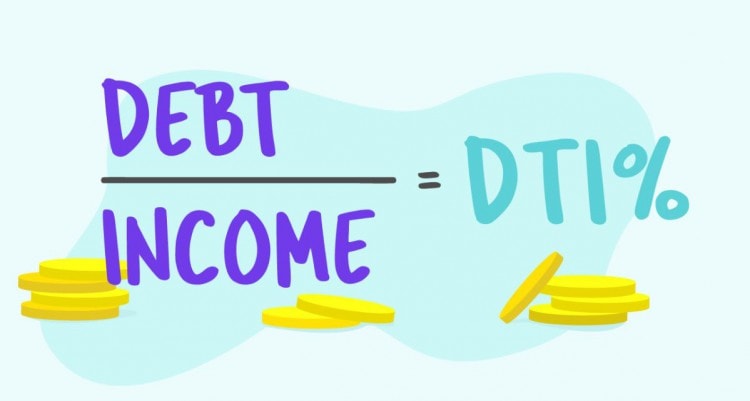
The world is constantly conspiring to make your life difficult. Just when you thought that your stable income and good credit score could get you that loan or mortgage, it throws another constraint at you. THE DTI. Or, the Debt-To-Income Ratio. The lenders take the debt-to-income ratio very seriously when it comes to lending money.
Wondering what is Debt-To-Income Ratio?
In layman’s language, it is your spending versus your earnings.
In professional terms, the Debt-to-income Ratio or the DTI is a measure reflecting your financial health. It is a percentage of your monthly income that goes into paying off other loans, credit card bills or mortgages. It showcases your monetary outgoings in respect to your incomings.
Your DTI decides your creditworthiness, and your ability to manage monthly repayments of the mortgage or loan that you wish to apply for. It helps the lender analyse the increase in your financial burden with an added monthly repayment, and helps him evaluate the risk in repayment of the loan/mortgage.
This is how you calculate your DTI:
The Debt-to-Income Ratio is a percentage of your monthly spending and income. The mathematical formula for calculating DTI is:

Your recurring monthly debt includes your car and/or student loan payments, credit card bills, rent, mortgage payments, and child support. It should NOT include payments made for groceries, cell phone bills, monthly utility bills, entertainment expenses or insurance expenses.
Your gross wages (before tax) should include not just your salaried income, but any benefit, child support and freelance income too.
It does not end there.
The DTI is not just DTI. It is further divided into two categories: the Front-end DTI, and the Back-end DTI. This is the difference-
The Front-end DTI includes only the monthly payments dedicated to housing costs. These include mortgage payments, mortgage taxes, and insurance.
The Back-end DTI includes all monthly debt payments that take into account car loans, student loans, credit card bills and housing and mortgage costs. In other words, the back-end DTI includes the expenses of the Front-end DTI, and is always higher than the latter.
Lenders usually prefer the back-end DTI percentage, but some lenders might consider your front-end DTI too.
“The Lower, the Better”
Let us understand it this way. The lender wants you to have enough room in your income to accommodate one more monthly payment. If you are already spending 50% of your income in paying off other debts, you are bound to have less scope for managing another payment, given that you have to use your rest 50% in monthly utility expenses.
A lender is bent towards approving your loan when you are a low-risk borrower. You are a low-risk borrower when there is enough scope in your income to manage another monthly payment. And what happens when your recurring monthly debt is low. This mathematically leads to a lower debt-to-income ratio.
Hence, the lower your debt-to-income ratio, the lesser threat you pose to the lender.
How low is LOW?
Now we know that a lower debt-to-income ratio pleases the eye and heart of a lender, and makes us a less risky investment. But which number is low to the lender or the creditor?
The best low is anything lower than 36%. That is, your spending should be less than 36% of your income. This figure indisputably makes you a low-risk borrower. Any lender would be happy to give you a mortgage or a loan if you fall under this category.
Between 36-43% is a slightly tense area, but you can still get your application approved. This reflects that you are handling your debt adequately, but can fall into trouble when unforeseen expenses occur. The lenders tend not to go beyond 43% DTI nowadays. You may also be asked to attach some additional security to your application in such a case.
Higher than 43% will NOT get you a mortgage/ loan easily. You fall into the high-risk category with more than 43% debt-to-income ratio. If you fall under this category, you are advised to take action to lower the ratio, in case you are thinking of applying for a Guaranteed Loan in the UK from British Lenders anytime in the future.
Coming down the ladder
Basic mathematics tells us that to lower the value of a fraction, you either decrease the numerator or increase the denominator. Since the debt-to-income ratio is calculated using a fraction, you can reduce it by either increasing your income or decreasing your expenditure.
You can achieve this in the following ways:
- Take up a part-time job or ask for a raise at your current job. This will help you increase your income.
- You can also try switching jobs to get higher pay.
- To decrease your outgoings, reduce avoidable expenditure, and focus on clearing off your debts.
- One way to reduce your debts is by starting with the smallest one. Pay off the smallest loan or debt first, as that would be easier. Once that is over, focus on the next smallest and move up.
- Another clever way of reducing your monthly expenses is by focussing to pay off the loan or mortgage with the highest interest. This might cost you a lot in the beginning, but will be highly beneficial to you in the long run. When that is paid off, move on to the next highest. You will experience a gradual decrease in the amount going out of your pocket.
Modern problems need modern solutions. And financial problems need financial solutions. The financial market is based only on numbers and figures, going higher or lower. Keep your numbers aligned to the market trends, and you would sail smoothly through any hardship.
